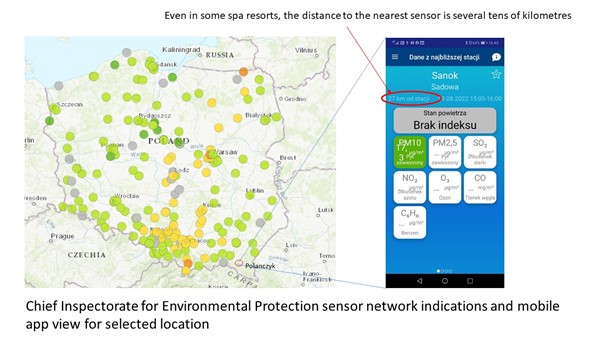Clear Air Defence Tool project is an integral part of the Ambient Connectivity stream and a part of Orange’s vision of the network of the future, described in the mentioned above Orange’s White Paper, which seeks to address environmental, social and geopolitical challenges and create the desired vision of a sustainable network contributing to the 2030 goals.
This post identifies a number of technical issues that must be resolved during eventual implementation as well as the need of a proper business case for such a service.
Air quality plays an essential role in people´s health and has a directly proportional relationship to health issues. Breathing poor-quality air can cause many long-term and short-term health effects [1] . The impact on health is more important within the vulnerable group such as older people and children. Children are indeed particularly vulnerable because physical development requires an adequate level of air quality [2] .
Of all atmospheric pollutants, the World Health Organization [3] considers atmospheric aerosols (particulate matter) with a diameter of 2.5 μm or less (so called PM 2.5) to be the most harmful to human health, as such fine dust enters the blood directly through the lungs, causing damage to all organs. Along with PM 10, it is one of the main components of pollution measured to assess air pollution.
The first steps to address air pollution consist in identifying sources of pollution, measuring the levels of pollutant constituents, and assessing the movement of polluted air. On this basis, further actions can be taken, both active, associated with the elimination of sources of pollution, and passive, consisting in avoiding contact with polluted air.
The sources of such pollution in Poland are well known. Although the number of old coal-fired heating cookers in Polish homes is falling steadily year by year, there is still much to be done to combat smog. Almost 3 million Polish households still use off-class heating boilers fired by coal or wood, according to the latest report by the “Polish Smog Alert” [4]. This means that the need to assess air pollution is and will continue to be necessary for many years to come in order to effectively enforce the right to breathe clean air.
As for the measurements, there are different techniques for monitoring the state of air pollution. Measurements can be made using mobile measuring points or pollution meters worn by people. However, the most effective method is a continuous monitoring of pollution using a fixed network of measuring devices, which allows the collection of data over long time intervals while maintaining the closest approximation to the real human environment.
Today in Poland, the air quality measurement network of the State Monitoring [5] relies on about 260 measurement stations. Global community platforms such as Airly, IQAir, Syngeos, Clarity provide readings from several hundred measurement points in Poland. However, even the creation of a virtual network that takes into account all readings will not ensure a density of measurements that would allow correct analysis in all areas of the country.

Increasing the number of air quality measurement points where necessary and densifying the measurement network would allow better diagnosis of atmospheric pollution, paving the way to efficent air-quality actions based on relevant, representative and reliable information/data. Building a network of sensors with the right density and deployment is a complex optimization issue that involves minimizing costs while providing adequate network coverage and network access [6]. Thanks to its ubiquitous distribution across the territories, the telecommunications infrastructure (RAN base stations, outdoor cabinets, technical buildings) constitutes an ideal grid to deploy atmospheric pollution measurement stations.
Howerer the identification of suitable, viable business model is the most important prerequisite before evolving the telecommunication infrastructure to support air pollution measurement. The methodology adopted in building business models is the BMC methodology developed by (Osterwalder et al.) [7].
In the framework of the Clear Air Defence Tool project several aspects have been analysed concerning the common citizen diagnostics of the air condition in Poland. As far as many parameters can be used to assess the air quality, a first scoping issue is related to the selection of the relevant parameters, providing a sufficient, usable and reliable information without extra-costs. The next issue is related to the procurement process to select the most efficient measurement instruments of reasonable price. At last, a third issue is technical with the integration of these measurement instruments within an existing telco infrastructure on one hand, and the storage and processing of the air-quality information/data.
The economic equation is important to implement a balanced solution demonstrating a real societal progress, still ensuring the control of costs. In the case of a civic network, such a compromise approach has more chance to gain adhesions across stakeholders.
Fortunately, recent years have brought new technical devices and it is possible to build a measurement network based on relatively cheap instruments. Just as important as choosing the right sensors is building a network with the right density. In fact, this is the main added value of this project, to densify the network of sensors levering on the Telco Infrastructure. This proposal aims to overcome the weaknesses of the current national network or other global platforms (several hundred sensors across the country). The densification of sensors proposed by Clear Air Defence Tool project responds to the challenges arising from the dispersion of several millions of local pollution sources. Through such an innovative solution, Orange acts as a partner into the air quality ecosystem to deliver a contributing action that brings environmental progress to the society.
Finally, the most important issue is to elaborate a viable business model for a telecommunications operator in compliance with the future network strategy and the CSR commitments. The benefits for a company such as Orange would involve not only building the image of a socially active company, but also fostering emergence of the Air-quality ecosystem and committing to the technical integration of the various practical possibilities of sensing into networks and smart home solutions. The digital player that can elaborate a value proposal combining premium connectivity, trust intensive network services, and data engineering can develop a competitive advantage to capture market with smart home solutions and offer advanced services to B2B and B2B2C players such as real estate developers for short term, institutions & collectivities (schools) for mid term, but also residential custumers at long term. The described Use Case should be understood as the first step towards a wider offer addressed to a whole range of customer segments.
The current state of work in the project has been made up of the efforts of several Orange teams, including Orange Innovation Poland and Customer and Market Knowledge Department. Implementation of the project will be a subject of the future studies, not addressed in this document and will be anchored in Orange’s network business vision contained in the Strategic Roadmap 2030, strategic directions for establishing the foundation for sustainable 6G networks that bring value to society and exploring new sources of value for networks and infrastructure.
Sources :
[1] “Health consequences of air pollution on populations,” [Online]. Available: https://www.who.int/news/item/15-11-2019-what-are-health-consequences-of-air-pollution-on-populations.
[2] “Air pollution and child health: prescribing clean air,” [Online]. Available: https://www.who.int/publications/i/item/WHO-CED-PHE-18-01
[3] “Ambient (outdoor) air pollution,” [Online]. Available: https://www.who.int/news-room/fact-sheets/detail/ambient-(outdoor)-air-quality-and-health
[4] “Polish Smog Alert,” [Online]. Available: https://polskialarmsmogowy.pl/smog/skad-sie-bierze-smog/
[5] “Polish Inspectorate for Environmental Protection,” [Online]. Available: https://powietrze.gios.gov.pl/pjp/content/measuring_air_assessment_zone_info
[6] Boubrima, A.; Matigot, F.; Bechkit,W.; Rivano, H.; Ruas, A. Optimal Deployment of Wireless Sensor Networks for Air Pollution Monitoring. In Proceedings of the 2015 24th International Conference on Computer Communication and Networks (ICCCN), Las Vegas, NV, USA, 3–6 August 2015; IEEE: Piscataway, NJ, USA, 2015.
[7] A. P. Y. B. G. S. A. P. T. K. J. &. N. C. Osterwalder, “Value Proposition Design,” Journal of Business, no. 3(1), pp. 81-89, 2015.











